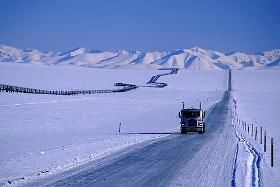Got Pulled Over!
Topic 17330 | Page 8

Joshua P says...
I only used it when out of hours...
Wait, what? In your original post you never mentioned being out of hours. Were you in fact out of hours when you off-duty drove to the truck stop? If so, there's no gray area there. That's a clear violation.
Have you ever used od driving? Have you seen the qc message that comes up when you use it? My original post was mentioning using od driving based on that message, i even showed the trooper the message and he never heared of it. Now the recent post i mentioned when im out of hours i used it when empty. To add to it i was not on a load and had to vacate the property. I no longer use od driving at all not even on the way home, ill go into violation before i use it. The trooper did mention that if you have no hours to drive and the shipper or reciever tells you to leave, they will be held liable.
Shipper:
The customer who is shipping the freight. This is where the driver will pick up a load and then deliver it to the receiver or consignee.
Yes I've used OD driving several times and have received the qc mssg each time. But I think it's just a generic computer generated mssg triggered by the OD use. It doesn't differentiate between illegal or legal use. In other words, it doesn't know if you are out of hours when it spits out the mssg.
The 14 hr rule is pretty clear though. You can't drive at all after 14 hrs, irregardless of OD driving, loaded or unloaded.
So what I'm saying is if you were out of hours and still OD driving, that would be the reason for the falsification ticket.
I wasn't trying to be critical, just trying to understand for clarification. I can see where the qc mssg is confusing and could lead many drivers to think it's ok to use line 5 even though they are out of hours.
Maybe that's why so many companies don't allow line 5.

First time posting, I recently ran into a situation myself where dispatch was telling me that I could use line5 to drive my tractor trailer, empty, to the nearest safe haven after delivery. From what I understand this was not the intended use of personal conveyance/line5 and it seems like the FMCSA agrees. The quote below is from the background information provided in paragraph 2 of the FMCSA proposed changes to the interpretation, link here hopefully FMCSA Proposed changes
"The previous guidance, which required the CMV to be unladen, was written for combination vehicles, where the driver could readily detach the trailer and use the unladen tractor for personal conveyance."
On top of that, this circumstance in particular is called out explicitly as being a continuation of the trip under section b3 of the proposal.
"Continuation of a CMV trip in interstate commerce , even after the vehicle is unloaded. In this scenario, on-duty time does not end until the driver reaches a location designated or authorized by the carrier for parking or storage of the CMV, such as a permanent residence, authorized lodging, or home terminal."
Terminal:
A facility where trucking companies operate out of, or their "home base" if you will. A lot of major companies have multiple terminals around the country which usually consist of the main office building, a drop lot for trailers, and sometimes a repair shop and wash facilities.
Combination Vehicle:
A vehicle with two separate parts - the power unit (tractor) and the trailer. Tractor-trailers are considered combination vehicles.
CSA:
Compliance, Safety, Accountability (CSA)
The CSA is a Federal Motor Carrier Safety Administration (FMCSA) initiative to improve large truck and bus safety and ultimately reduce crashes, injuries, and fatalities that are related to commercial motor vehicle
FMCSA:
Federal Motor Carrier Safety Administration
The FMCSA was established within the Department of Transportation on January 1, 2000. Their primary mission is to prevent commercial motor vehicle-related fatalities and injuries.
What Does The FMCSA Do?
- Commercial Drivers' Licenses
- Data and Analysis
- Regulatory Compliance and Enforcement
- Research and Technology
- Safety Assistance
- Support and Information Sharing
CMV:
Commercial Motor Vehicle
A CMV is a vehicle that is used as part of a business, is involved in interstate commerce, and may fit any of these descriptions:
- Weighs 10,001 pounds or more
- Has a gross vehicle weight rating or gross combination weight rating of 10,001 pounds or more
- Is designed or used to transport 16 or more passengers (including the driver) not for compensation
- Is designed or used to transport 9 or more passengers (including the driver) for compensation
- Is transporting hazardous materials in a quantity requiring placards
Interstate Commerce:
Commercial trade, business, movement of goods or money, or transportation from one state to another, regulated by the Federal Department Of Transportation (DOT).
Interstate:
Commercial trade, business, movement of goods or money, or transportation from one state to another, regulated by the Federal Department Of Transportation (DOT).
Fm:
Dispatcher, Fleet Manager, Driver Manager
The primary person a driver communicates with at his/her company. A dispatcher can play many roles, depending on the company's structure. Dispatchers may assign freight, file requests for home time, relay messages between the driver and management, inform customer service of any delays, change appointment times, and report information to the load planners.New Reply:
New! Check out our help videos for a better understanding of our forum features

















Preview:
This topic has the following tags:
FMCSA Hours Of Service Logbook Questions Understanding The Laws







 TT On Facebook
TT On Facebook
Joshua P says...
Wait, what? In your original post you never mentioned being out of hours. Were you in fact out of hours when you off-duty drove to the truck stop? If so, there's no gray area there. That's a clear violation.